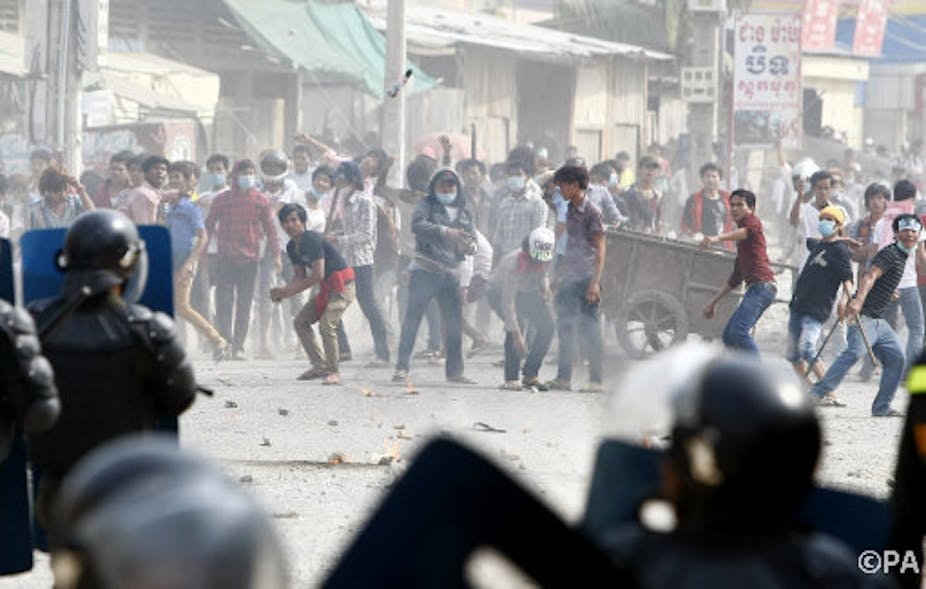In the past week, violence has hit several industrial areas in Phnom Penh, Cambodia, where hundreds of thousands garment workers started protesting against unfair working conditions. They are demanding a significant increase in their meagre salaries, from the current US$100 per month to $160. Workers, alongside a wide range of activists, clashed with police and military forces, who opened fire, killing four people and injuring many more.
At the time of writing, the Cambodian government has issued a ban on assembly and public gatherings. While these clashes represent the escalation of a rather complex political crisis in Cambodia, involving not only workers and unions but also opposition parties and different civil society groups, united against Prime Minister Hun Sen, they also once more remind us of the unacceptable model our global manufacturing system is hanging onto.
The “modern” ready-made garment industry has always been a case of capitalism at its ugliest, its abysmal working conditions and practices persisting since its birth in the industrial revolution. It was in 1911 that a fire in New York consumed the Triangle Shirtwaist Factory and claimed the lives of 146 garment workers, primarily young migrant women. The economist John R Commons coined the word “sweatshop” as early as 1901.
Over the past century, the sweatshop model has globalised, travelled the world, and continually relocated in its endless search for new reservoirs of cheap labour. This has accelerated with the rise of neoliberalism and “export-orientation” has become a byword for speedy development. The relocation of garment factories to the developing world has been accompanied by a progressive decline of prices for consumers, and consumerism has been framed as a means to alleviate world poverty, not only through fair trade schemes but also through “aid for trade” rhetoric. Today, in the context of what is known as the “retail revolution”, western consumers can purchase a pair of jeans on the high street for £5 – and also be gratified by the thought that, after all, they are shopping to save the world.
The struggle goes on
In the garment industry, violence and exploitation are pretty much the norm, experienced by workers in various ways. In many cases, workers sweating in global garment factories are migrants coming from rural areas, “ejected” from their villages by poverty, unemployment or landlessness, with the pallid hope of a better future for their families. In many cases they are young women, passing from the hands of the family patriarch to those of the market patriarch, who loves the lower wages they are willing to accept. Once in the factories, they face harsh and intense working conditions and extremely low wages.
After ten years of studying, researching, and investigating this industry, I am still astonished by the innumerable shades in which its exploitation is manifested, and by the myriad struggles garment workers face not just at work, but in their daily lives. In India, workers struggle to find decent housing, and live in filthy shacks at the margins of urban metropoles, enlarging the perimeters of Mike Davis’ “Planet of Slums”. In China, workers are instead locked into companies’ dormitories, each and every moment of their lives fully commodified and regulated.

In Bangladesh and Pakistan, garment workers have fought for their lives in the midst of the collapse of the buildings where they worked. Chillingly, after more than a century, the Rana Plaza disaster in Dhaka perfectly followed the pattern of the Triangle Shirtwaist Factory fire. In both cases, hundreds of workers were locked into an old, crumbling, overcrowded building, unable to escape.
In Cambodia, workers are fighting for their labour rights and livelihoods on the streets, demanding a fairer compensation for their sweat. After all, it is their sweat – along with that of other Asian, Latin American, or African workers – that clothes the world. In response to their demands, they have been shot and beaten on those streets by their governments.
The events unfolding in Phnom Penh are the throes of a regime losing political legitimacy in the face of mounting opposition; but they are also the output of a profoundly unequal global capitalist regime, in which broad swathes of the world exist merely to provide cheap labour. For Cambodia to remain a desirable destination for global capital, wages must be kept low. In this sense, the Cambodian government is using violence not only against national opposition, but also in defence of its position within the neoliberal world order.
In his 1997 article “In Praise of Cheap Labour”, economist Paul Krugman argued that despite the “rhetoric” over abysmally low working conditions, workers in developing regions were the primary beneficiaries of the current global architecture of manufacturing production as, after all, any job, however bad, is better than no job. As workers march in Cambodia to fight for their own retail revolution, it is time to challenge once and for all this short-sighted, narrow argument. And while we must condemn the Cambodian government for its bloody attack on its own people, we should also finally acknowledge that also our own clothing is blood-stained, in each and every seam, and that we are all in it together.

